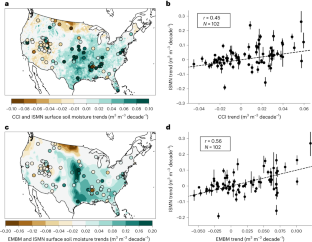2024-02-05 ノースウェスタン大学
<関連情報>
- https://news.northwestern.edu/stories/2024/02/understanding-how-soil-traps-carbon/
- https://www.pnas.org/doi/10.1073/pnas.2316569121
水-粘土界面における生体分子の吸着階層における静電結合と水ブリッジング Electrostatic coupling and water bridging in adsorption hierarchy of biomolecules at water–clay interfaces
Jiaxing Wang, Rebecca S. Wilson, and Ludmilla Aristilde
Proceedings of the National Academy of Sciences Published:February 8, 2024
DOI:https://doi.org/10.1073/pnas.2316569121

Significance
The storage of biomolecules derived from plants and microbes in soils represents an important reservoir at the interface of carbon sequestration and biogeochemical carbon cycling. Association with clay minerals controls the residence time of these biomolecules in soils in semi-arid and temperate climates, by influencing accessibility to microbial turnover. Here, we combine experiments and molecular modeling to investigate biomolecule–clay complexes serving as precursors to soil organic matter. We obtain adsorbate structures and binding energies to reveal electrostatic and water-bridging interactions that drive the adsorption and nanopore trapping of chemically diverse biomolecules within smectite-type clays. These findings advance a fundamental understanding of the mechanisms critical to the role of clays in organic matter retention in different soil conditions.
Abstract
Clay minerals are implicated in the retention of biomolecules within organic matter in many soil environments. Spectroscopic studies have proposed several mechanisms for biomolecule adsorption on clays. Here, we employ molecular dynamics simulations to investigate these mechanisms in hydrated adsorbate conformations of montmorillonite, a smectite-type clay, with ten biomolecules of varying chemistry and structure, including sugars related to cellulose and hemicellulose, lignin-related phenolic acid, and amino acids with different functional groups. Our molecular modeling captures biomolecule–clay and biomolecule–biomolecule interactions that dictate selectivity and competition in adsorption retention and interlayer nanopore trapping, which we determine experimentally by NMR and X-ray diffraction, respectively. Specific adsorbate structures are important in facilitating the electrostatic attraction and Van der Waals energies underlying the hierarchy in biomolecule adsorption. Stabilized by a network of direct and water-bridged hydrogen bonds, favorable electrostatic interactions drive this hierarchy whereby amino acids with positively charged side chains are preferentially adsorbed on the negatively charged clay surface compared to the sugars and carboxylate-rich aromatics and amino acids. With divalent metal cations, our model adsorbate conformations illustrate hydrated metal cation bridging of carboxylate-containing biomolecules to the clay surface, thus explaining divalent cation-promoted adsorption from our experimental data. Adsorption experiments with a mixture of biomolecules reveal selective inhibition in biomolecule adsorption, which our molecular modeling attributes to electrostatic biomolecule–biomolecule pairing that is more energetically favorable than the biomolecule–clay complex. In sum, our findings highlight chemical and structural features that can inform hypotheses for predicting biomolecule adsorption at water–clay interfaces.



